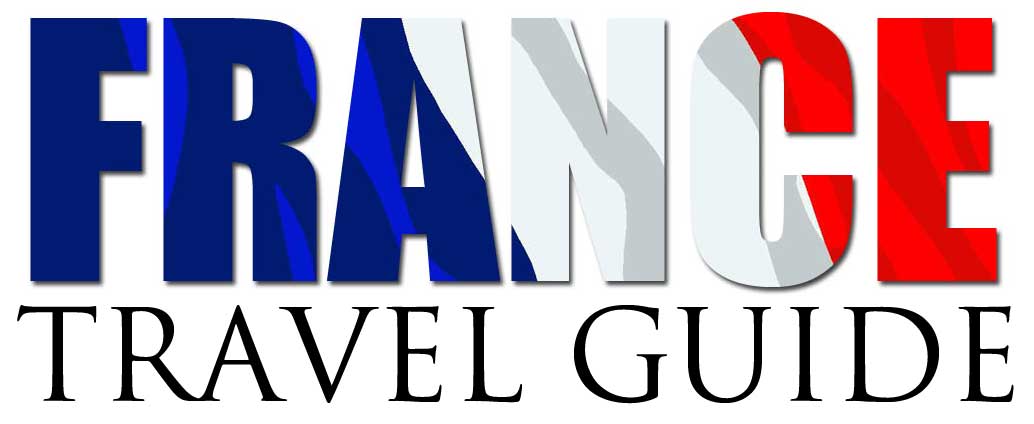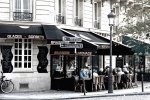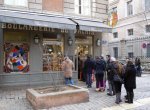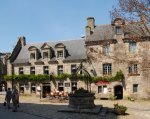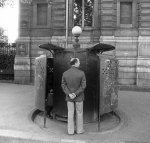French truffles
French truffles are collected from mid-November until mid-March using either a dog or a pig. Dogs are not naturally inclined to detect truffles and have to be trained, making the dog itself a highly valuable ‘tool of the trade’. Curiously, it is rarely a pure breed of dog that has the knack, but a mongrel, rough-and-ready dogs that have developed a flair for seeking out truffles.
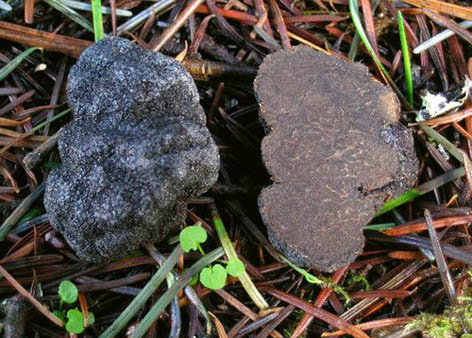
© M. Trappe
Pigs on the other hand are drawn to the aroma of the truffles, which for them contains sexual hormones attractive to their kind.
But a couple of hundred kilos of determined pork can prove remarkably uncooperative when hovering on the brink of porcine ecstasy, and the owner needs to be alert, strong and resourceful if he is to save the truffle.
Not surprisingly, when a pig finds a truffle its instinct is to eat it, and the resulting tussle can be quite dramatic; the man usually wins, but the pig (or dog) must be rewarded. Pigs, however, are not disposed to wandering over the large areas necessary to find the truffles.
So, many hunters carry their pigs in a wheelbarrow or under their arm until a sudden squeal of delight announces the proximity of a truffle. Today, some French truffles hunters do without either dog or pig, and just use their noses and a certain je ne sais quoi to find the truffles.
Apart from the taste, which puts it on a culinary par with saffron, foie gras and caviar, the truffle was long held to possess aphrodisiac properties. Almost inevitably, given the French predilection for debating matters gastronomic, opinions are divided, but you certainly won’t get any French chef trying to dissuade you from the notion.
Sadly, the only evidence to support the claim is that the odour of the truffle contains alpha-androstenol, a chemical thought to be a pheromone and clearly attractive to pigs.
Whatever the case, French truffles, a humble globule of highly prized fungus that matures through the harsh winters at the foot of Provençal oak trees, is undoubtedly in a league of its own.
The history of French truffles
Traces of truffles have been found in 4000-year-old terracotta tablets discovered is Mesopotamia, the area between the Tigris and the Euphrates. For hundreds of years synonymous with banquets, conviviality and unforgettable moments of savoury delight, the best French truffles are (arguably, very arguably) found between the Lubéron and the slopes of Mont Ventoux.
During the 14th century, when the Papacy was in Avignon, the popes, their cardinals and archbishops brought with them a passion for good food and wine, including the truffle. But it was during the 19th century that man’s love affair with French truffles really began, when Joseph Talon and Auguste Rousseau, both from Carpentras, had the idea of cultivating truffles; it was a project that never really quite succeeded.
At a mundane level the truffle, a rough, misshapen and visually unappetising black gobbit of fungus, is renowned for its gastronomic, aromatic and dietary qualities. In medieval times it was used for medicinal purposes, as a cure for all sorts of pain, gout and general debility. Until as recently as the 19th century, doctors prescribed truffle water as a cure for vomiting and diarrhoea.
But it is largely thanks to its gastronomic qualities that the truffle is highly regarded today. It is, by common consensus, the noblest and most individual of all French delicacies. Known as ‘the Black Diamond’, the truffle is often described as a subterranean mushroom, but one that lives in symbiosis with a tree, usually an oak or hazel.
There are dozens of varities of French truffles. But the finest is the Tuber melanosporum, a winter truffle called the ‘Truffe du Perigord’ in the south-west of France, and ‘rabasse’ in Provence.
And although truffles can be found in many places, even as far afield as New Zealand, it is Provence that provides 80% of the truffle crop, mostly through its truffle markets in Carpentras in the Vaucluse and Richerenches in Tricastin, north-east of Orange.
An essay on French truffles
A passion for truffles can be a volatile commodity in the wrong hands, but when it comes from the heart of a master chef it invariably transforms into something quite wondrous.
Take the case of Christian Etienne, Maître Cuisinier de France, from Avignon. Amid the modestly understated elegance of his eponymous restaurant adjacent to the Palais des Papes, he prepares his cuisine with an intense pride, cultivated in the kitchens of his mother and grandmother and developed in the restaurants of Paris, that has earned him one Michelin star already.
During the summer months, his menus favour the colours, perfumes and produce of Provence – sun-dried tomatoes, olive oil, Provençal herbs – and the fish of the Mediterranean – monkfish, red mullet, sea bass, lobster and cuttlefish – but in winter his stage supports quite a different act, for then it is the time of the truffle, or la rabasse as they call it here.
Throughout France, and much further afield, Christian Etienne is regarded as a master of the truffle, a culinary wizard for whom la magie de la Rabasse is simply spell-binding.
‘The truffle,’ he told me, ‘is an object of intense desire, like a nugget of gold.’ He paused: ‘Non’, he said on reflection, ‘to the rabassier or the gourmand, the truffle is more precious than gold.’
I looked for the mischievous twinkle in his eye, but there was none. He was serious.
In his book, La Magie de la Rabasse, Christian describes the ritual of the gourmand as a dish containing truffles is laid before him.
‘First, he uses his nose to gauge the aroma of the truffle, half-closing his eyes in order not to distract his senses. Then, still with his eyes half-closed, he leans forward over his plate inhaling deeply and wrinkling his brow in a gesture of delight before smiling approvingly to the other guests.’ This single appreciative act is reward enough for the chef: ‘It’s an involuntary thing, something you are not aware of doing’, Christian told me.
I know he’s right, because that’s exactly what I did.
In A Year in Provence, Peter Mayle portrays the secretive world of the truffle and the truffle hunter (the rabassier or the caveur), where ‘men stand in tight, preoccupied groups looking, sniffing and finally weighing wart-encrusted, earth-cover lumps that are handled with reverential care.’
In Carpentras, the market is held from 8-10am each Friday from the Friday before the beginning of the Saint-Siffrein Fair (27 November) until the end of March, in Place Aristide Briand opposite the Hôtel Dieu, a usually peaceful square surrounded by plane trees. In summer, there’s no clue to its winter identity; just another delightful square in another lovely Provençal town.
There are no loud colours here, no-one stands out, Hessian sacks, panniers, bowls and other vessels are full of black lumps of earth, and within minutes the air is laden with the distinctive aroma of truffles – you can’t describe it, but once experienced it is never forgotten.
French truffles
related articles
Recent Articles
-
French Food and Drink - No BS Guide for lovers of Food, Wine, Liqueurs
Aug 28, 19 03:18 AM
Our guide to French food and drink for those who love traditional French food along with our no BS guide to understanding French wine and liqueurs
-
Things To Do In Carcassonne The Ultimate Tourist Guide
Aug 24, 19 06:26 PM
The ultimate tourist guide to things to do in Carcassonne when you visit this wonderful town in Aude France. Discover the places to go and see in Carcassone.
-
Lyon Old Town Guide to Vieux Lyon
Aug 18, 19 07:48 AM
Your complete guide to Lyon old town otherwise known as the Vieux Lyon. Don't miss this amazing part of the city if you're visiting Lyon in France.
-
18 French Villages You Must Visit Most Beautiful Villages in France
Aug 17, 19 06:31 AM
Our guide to the 18 most beautiful French villages you simply must visit. Loads of info, photos and facts in our ultimate villages in France tourist guide
-
What a Pissoir - The True Story of France's Unique Urinals
Aug 13, 19 03:47 PM
Is there anything more French than a pissoir? Sadly on the decline nevertheless the pissor is an endring image of the country. This is their story
